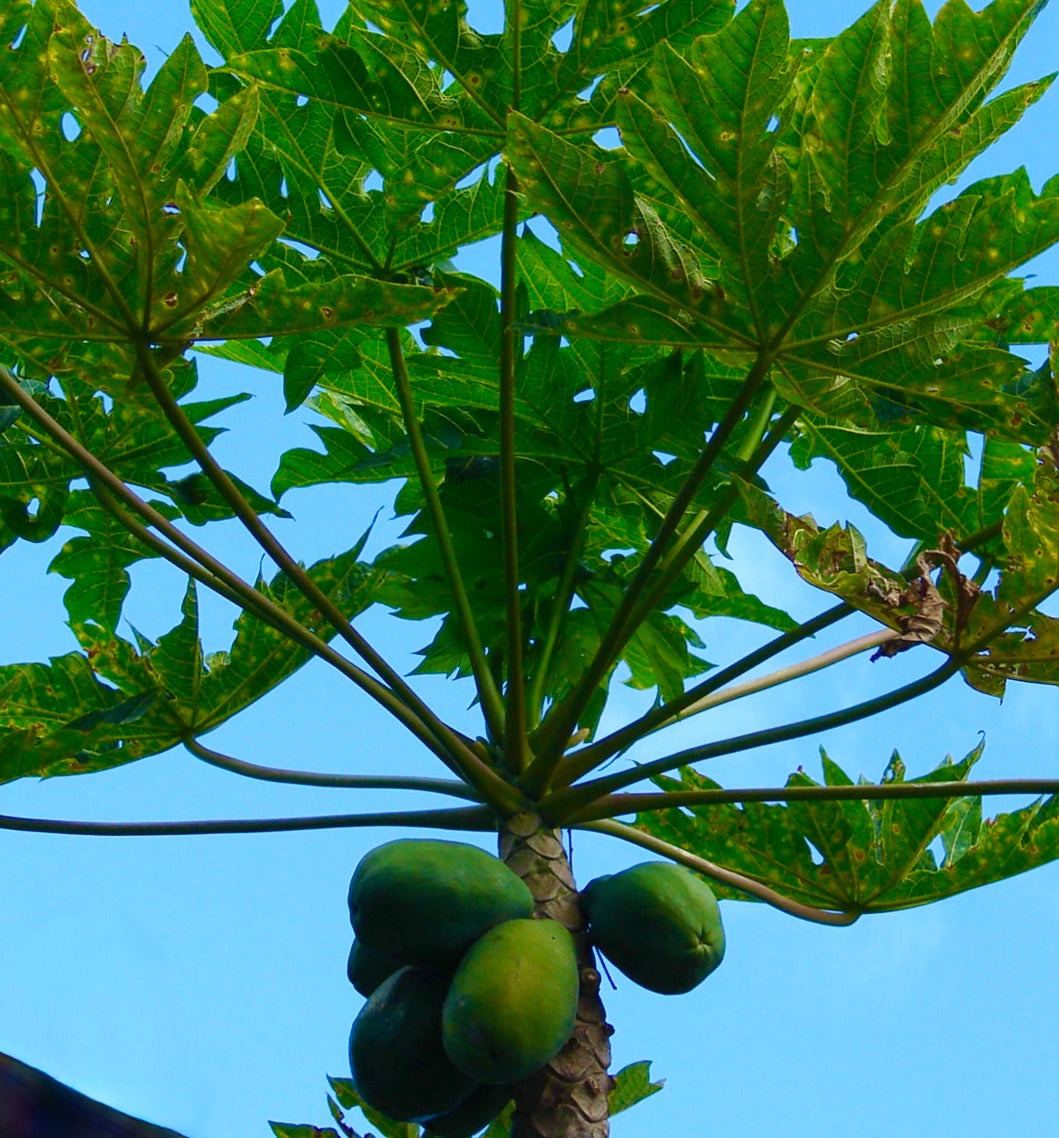- Catalogue Plants
Carica papaya 10-20cm
Carica papaya 10-20cm
Couldn't load pickup availability
Plant Description
Carica papaya, commonly known as papaya, is a tropical fruit tree that's prized for its delicious, sweet, and vibrant orange flesh. This tree is famous for its exotic appearance and the tropical flavor of its fruit.
Papaya is a fast-growing, evergreen tree that can reach heights of 15 to 30 feet (4.5 to 9 meters) or more. It has a single, unbranched trunk with large, deeply lobed leaves at the top, creating a distinctive umbrella-like appearance. The leaves are usually about 20 to 28 inches (50 to 70 centimeters) in diameter. Papaya trees are dioecious, meaning they produce male and female flowers on separate plants. The flowers are typically white and fragrant, with male flowers having long, slender stalks and female flowers appearing closer to the trunk.
The most prized part of the papaya tree is its fruit. Papayas are large, oblong or pear-shaped, and have thin, green to yellow-orange skin that ripens to a golden hue when mature. The flesh is juicy, sweet, and usually orange, although some varieties have red or pink flesh. The center of the fruit contains numerous small, black seeds that are edible but often scooped out before consumption.
Cultivation:
-
Climate: Papaya trees thrive in tropical and subtropical climates. They require warm temperatures and are sensitive to frost. Ideally, they grow best in USDA hardiness zones 10 to 11.
-
Sunlight: Plant papaya trees in a location that receives full sun. They need at least 6 to 8 hours of direct sunlight daily for optimal growth and fruit production.
-
Soil: Papayas prefer well-draining soil with a slightly acidic to neutral pH. Amending the soil with organic matter can improve fertility and drainage. Sandy loam soils are often suitable.
-
Watering: Keep the soil consistently moist but not waterlogged. Papaya trees have shallow roots, so they benefit from regular and deep watering. Avoid water stress, especially during hot and dry periods.
-
Mulching: Apply a layer of organic mulch around the base of the tree to retain soil moisture, regulate temperature, and suppress weeds. Mulching helps keep the root zone cool.
-
Fertilization: Feed papaya trees with a balanced, slow-release fertilizer that includes micronutrients. Apply fertilizer every 2-3 months during the growing season. Avoid excessive nitrogen, as it can lead to vegetative growth at the expense of fruit production.
-
Pruning: Prune papaya trees as needed to remove dead or damaged branches and to maintain an open canopy. Regular pruning can also help improve air circulation and reduce disease risk.
-
Pests and Diseases: Keep an eye out for common pests like aphids, mealybugs, and spider mites. Papayas can also be susceptible to diseases like powdery mildew and bacterial spot. Proper care, including good sanitation practices, can help prevent these issues.
-
Harvesting: Papayas are ready for harvest when the skin turns yellow or orange and yields slightly to gentle pressure. Use a sharp knife to cut the fruit from the tree.
Carica papaya is a delightful tropical tree that adds a taste of the tropics to your garden or orchard. With the right care and attention to its specific needs, papaya trees can yield a bountiful crop of sweet, juicy fruits that are a treat for your taste buds.
IMPORTANT: Please be aware that picture 1 show adult plant with fruits not for sale, the offer is for a plant in the dimension indicated in title description.
Disclaimer: Please keep on mind that the plant may have grown since pictured. Also be aware that most plants change across seasons. If present foliage could have been fallen or change in its color.
Botanical family: Caricaceae
Botanical genus: Carica
Botanical species: Carica papaya
SKU:BA-1612-S
Cultivation
Cultivation
Additional information
Additional information
Plant Height: 10-20cm
Plant Diameter:
Picture Taken on:
Pot Size:
Grafted/Not Grafted:


